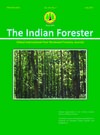Loranthus (Taxillus vestitus) Infestation in Mixed Oak Forest Sites in and around Nainital Catchment of Central Himalayan Region
DOI:
https://doi.org/10.36808/if/2017/v143i7/119022Keywords:
Taxillus vestitus, Loranthaceae, Infection Frequency, Infestation Intensity, Parasite.Abstract
Mistletoes are a diverse group of parasitic plants with a worldwide distribution. The parasite Taxillus vestitus (Loranthus vestitus) causes wide spread infestation in the oak (Quercus) forest of the Central Himalaya located between 1740 and 2292 m. The study was undertaken across nine oak dominated sites in Nainital forest division of Kumaun Central Himalaya to assess the percent infestation and infestation intensity by this parasite on different forest tree species such as Quercus leucotrichophora (Q. incana), Q. floribunda (Q. dilatata), Q. lanata (Q. lanuginose) and Populus ciliata. Quercus floribunda had mean maximum infestation frequency (53.43±12.96) and infestation intensity (40.78±7.0). The older trees, which were severely lopped, had higher infection % branch-1 however, overall younger trees were more severely affected by the parasite. The coniferous trees species were not infected by the parasite across the study sites.References
Arya N., Tewari B. and Ram J. (2012). The effect of natural and anthropogenic disturbance in forests canopy and its effect on species richness in forests of Uttarakhand Himalaya, India. ISSN: 1067-4136, Russian J. Ecology, 43(2): 117-121.
Aukema J.E. and Martinez del Rio C. (2002). Where does a fruit-eating bird deposit mistletoe seeds? Seed deposition patterns and an experiment. Ecology, 83 (12): 3489–3496.
Bach C.E., Kelly D. and Hazlett B.A. (2005). Forest edges benefit adults, but not seedlings, of the mistletoe Alepis flavida (Loranthaceae). J. Ecology, 93:79-86.
Curtis J.T. and McIntosh R.P. (1950). The interrelationship of certain analytic and synthetic phytosociological characters. Ecology, 31: 438-455.
Devkota M.P. and Acharya N. (1996). Mistletoes (Loranthaceae and Viscaceae) in the Kathmandu valley, Nepal: altitudinal distribution, Host trees, pollinators and seed dispersers. Acta Phytotaxonomica et Geobotanica, 47 (2):213-219.
Garkoti S.C., Akoijam S.B. and Singh S.P. (2002). Ecology of water relations between mistletoe (Taxillus vestitus) and its host oak (Quercus floribunda). ISSN 0564-3295.Tropical Ecology, 43(2):243-249.
Glatzel G. and Geils B.W. (2009). Mistletoe ecophysiology: host-parasite interactions. Botany, 87: 10–15.
Hosseini A. (2015). New mechanical methods and treatments for controlling of leafy mistletoe (Loranthus europaeus jacq.) on Persian oak trees (Quercus persica). Inter. J. Environmental Sciences, 5: (4) 1841-1849.
Kolodziejek J. and Kolodziejek A. (2013). The spatial distribution of pine mistletoe Viscum album ssp. austriacum (Wiesb.) Volmann in a scots pine (Pinus sylvestris L.) stand in Central Poland. Polish J. Ecology, 61(4): 705-714.
Kuijt J. (1969). The Biology of Parasitic Flowering Plants. University of California Press: Berkeley, 246pp.
Kunwar R.M. (2006). Diversity, distribution and host range of mistletoes in Godawari-Phulchoki area, Kathmandu, Nepal. J. Japanese Botany, 81(5):255-261.
Lavorel S., Smith M.S. and Reid N. (1999). Spread of mistletoes (Amyema preissii) in fragmented Australian woodlands: a simulation study. Landscape Ecology, 14: 147–160.
Nickrent D.L. (2002). Mistletoe phylogenetics: Current relationships gained from analysis of DNA sequences. In: The Proceedings of the Western International Forest Disease Work Conference,Waikoloa, Hawaii. pp. 48-57.
Polhill, R. and Wiens, D.W. (1998). Mistletoes of Africa. Kew Ed. ISBN. p. 370.
Ram J., Tewari B. and Pant C. (2006). Infestation of oak trees by the flowering parasite (Taxillus vestitus (Wall.) Danser) at Nainital in Uttaranchal. Current Science, 90(4): 562-563.
Rist L., Shaanker R.U. and Ghazoul J. (2011). The spatial distribution of mistletoe in Southern Indian tropical forest at multiple scales. Biotropica, 43: 50–57.
Sanguesa-Barreda G., Linares J.C. and Camarero J.J. (2012). Mistletoe effects on Scots pine decline following drought events: insights from within-tree spatial patterns, growth and carbohydrates. Tree Physiology, 32: 585–598.
Saxena A.K. and Singh J.S. (1982). A phytosociological analysis of woody species in forest communities of a part of Kumaun Himalaya. Vegetatio, 50: 3-22.
Singh J.S. and Singh S.P. (1992). Forests of Himalaya, Gyanodaya Prakashan, Nainital.
Tewari B. (2008). Canopy gap characteristics and regeneration status of Q. leucotrichophora A. Camus, in Uttaranchal Himalaya. Ph. D. thesis, Kumaun University, Nainital.
Upreti N. (1982). A study on phytosociology and state of regeneration of oak forests of Nainital, Ph. D. thesis, Kumaun University, Nainital, 481pp.
Watson D.M. (2001). Mistletoe- A keystone resource in forests and woodlands worldwide. Annu. Rev. Ecol.Syst. 32: 219-49.
Zweifel R., Bangerter S., Rigling A. and Sterck F.J. (2012). Pine and mistletoes: how to live with a leak in the water flow and storage system? J. Exp. Bot., 63(7): 2565–2578.
Downloads
Downloads
Published
How to Cite
Issue
Section
License
Unless otherwise stated, copyright or similar rights in all materials presented on the site, including graphical images, are owned by Indian Forester.





